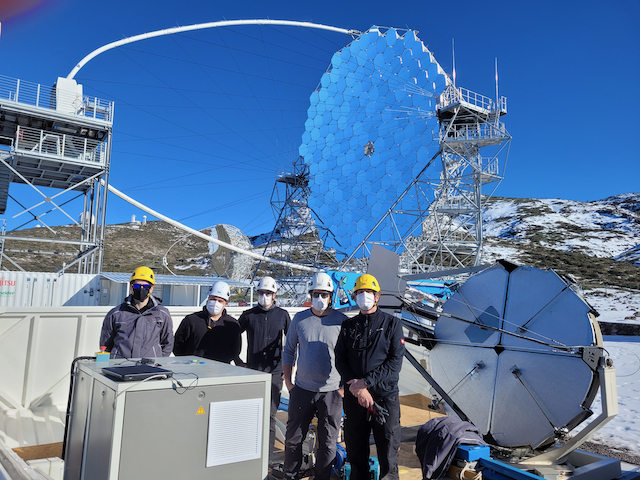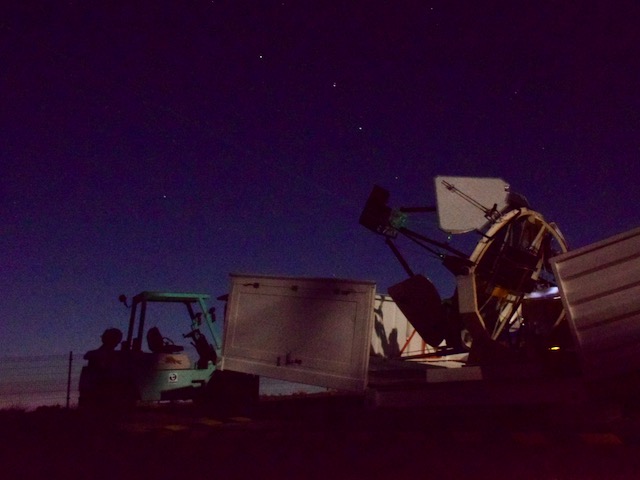CTAO North Raman Lidar Pathfinder
Cosmic very high-energy (VHE, E ≥ 30 GeV) gamma rays carry crucial and unique information about the most energetic phenomena in the Universe. The most sensitive experimental approach in VHE gamma-ray astronomy is based on simultaneous imaging of Cherenkov flashes from the VHE gamma ray induced air showers using multiple telescopes (imaging air Cherenkov telescopes or IACTs), and reconstruction of the primary gamma-ray properties from those images. The construction of a new generation IACT facility, the Cherenkov Telescope Array Observatory (CTAO) with design sensitivity improved by at least an order of magnitude compared to existing VHE instruments and extended energy coverage, started in 2022. CTAO is expected to enable the detection of more than 1000 new VHE gamma-ray sources over the whole sky.
Since the atmosphere is used as a CTAO calorimeter, atmospheric monitoring and the understanding of atmospheric processes is of paramount importance for its operation and the achievement of its science goals. The evolution of the main aerosol characteristics is extremely complex and requires the use of remote-sensing instruments, for example a Raman lidar. Laser light emitted by the lidar directly interacts with the atmospheric constituents and provides in its backscattering return the footprint of atmospheric ingredients as a function of altitude. A Raman lidar is foreseen in the CTAO baseline configuration, to determine atmospheric transmission from each point along its line-of-sight to ground up to distances of 30 km, and to provide the required improvement in reducing systematic uncertainties and increasing the duty cycle for the CTAO, compared to the current generation of Cherenkov telescopes.
The CTAO North Raman Lidar Pathfinder, also known as Barcelona Raman Lidar (BRL), is one of the two prototypes being developed for atmospheric characterization in the future Northern Site of the Cherenkov Telescope Array Observatory (CTAO) at the Observatorio del Roque de los Muchachos (ORM) on the Canary island of La Palma. CTAO North Raman Lidar Pathfinder was deployed to ORM in February 2021 and recorded first light on 25 March 2021. It is currently in the commissioning and evaluation phase to ensure that the prototype satisfies the requirements put forth by CTAO and afterwards to improve the lidar's reliability and performance. Based on these activities, the final CTAO North Raman Lidar is planned to be built at the Observatorio del Roques de los Muchachos by the end of 2026.
The CTAO North Raman Lidar Pathfinder team consists of about 20 scientists from three countries, Spain, Slovenia and Italy. Follow the link for a full list of institutions participating in the the collaboration.
Views of the CTAO North Raman Lidar Pathfinder, deployed for comissioning at the Large Size Telescope (LST) site, Observatorio del Roque de los Muchachos:



A comprehensive description of the CTAO North Raman Lidar Pathfinder and an updated status of the project can be found here , here and here. CTAO North Lidar Pathfinder project is presented in detail in its Technical and Scientific Description.
The official website of the Cherenkov Telescope Array Observatory is at www.cta-observatory.org.
Please refer questions regarding to the CTAO North Raman Lidar Pathfinder to:
Oscar Blanch (Co-PI): blanch@ifae.es
Markus Gaug (Co-PI): markus.gaug@uab.cat
Paolo G. Calisse (CTAO North Site Manager): paolo.calisse@cta-observatory.org
Samo Stanič (Web page): samo.stanic@ung.si